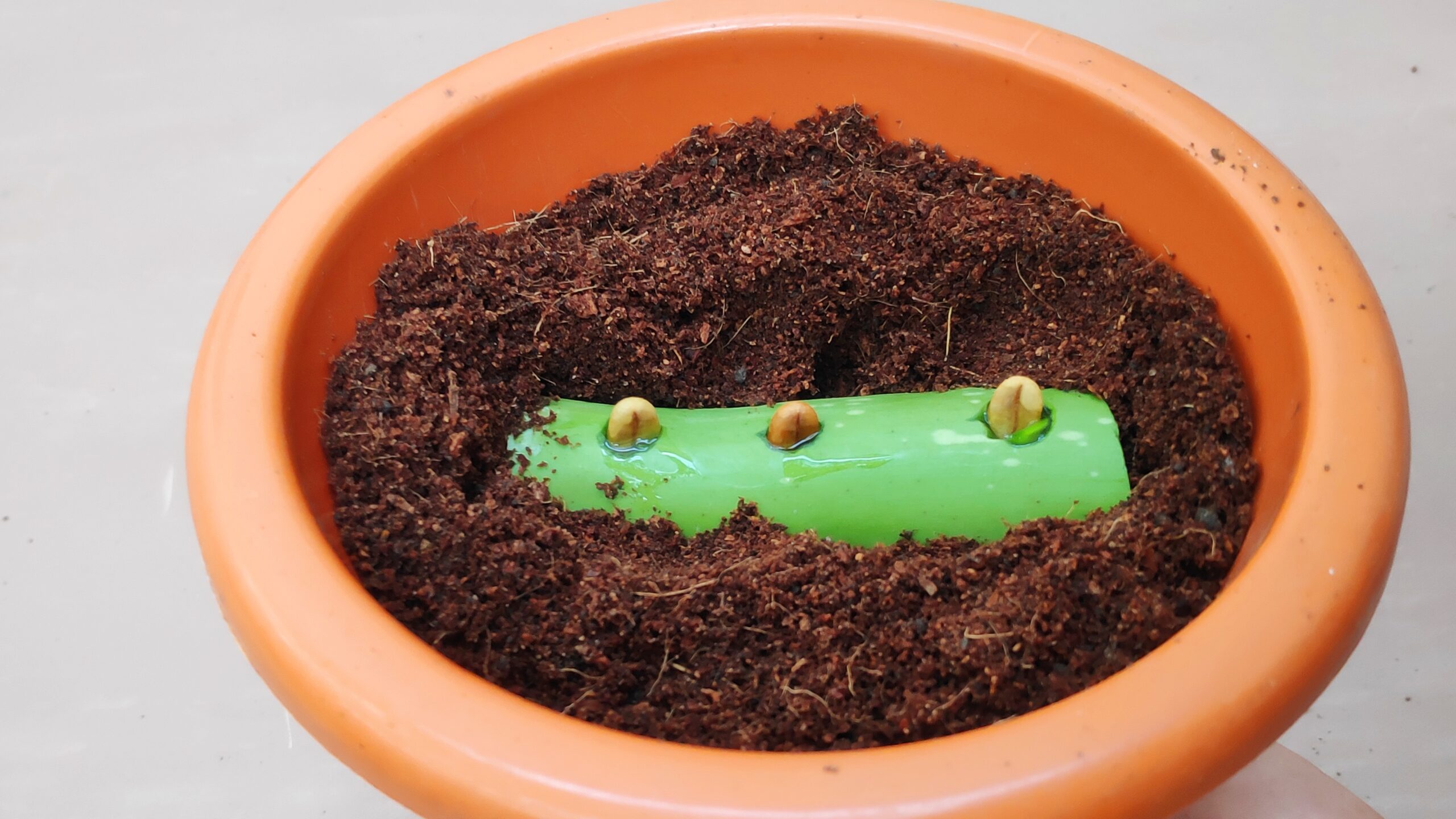What is cocopeat
Cocopeat is a natural organic growing medium. It is a fibrous material having a sponge-like texture and is widely used in gardening.
Cocopeat is obtained by crushing the fibrous husk of dried coconut. You must have often seen that while peeling dry coconut, many small fibrous particles fall from its peels. These small coir particles are known as coco peat or coco coir.
Cocopeat is also known by other names, such as Coco Powder, Coconut Dust, and Coir Dust.
Properties of cocopeat or coco coir
1. Anti-Fungal and Disease Resistance: Cocopeat has a natural resistance to diseases, fungi, pests, and weed growth. This makes it a safe and better choice for gardening and farming.
2. Lightweight: It is lightweight compared to traditional garden soil, making it easy to handle and transport. Its lightness also reduces the weight of grow bags and planters when mixed with normal soil (especially in hanging pots).
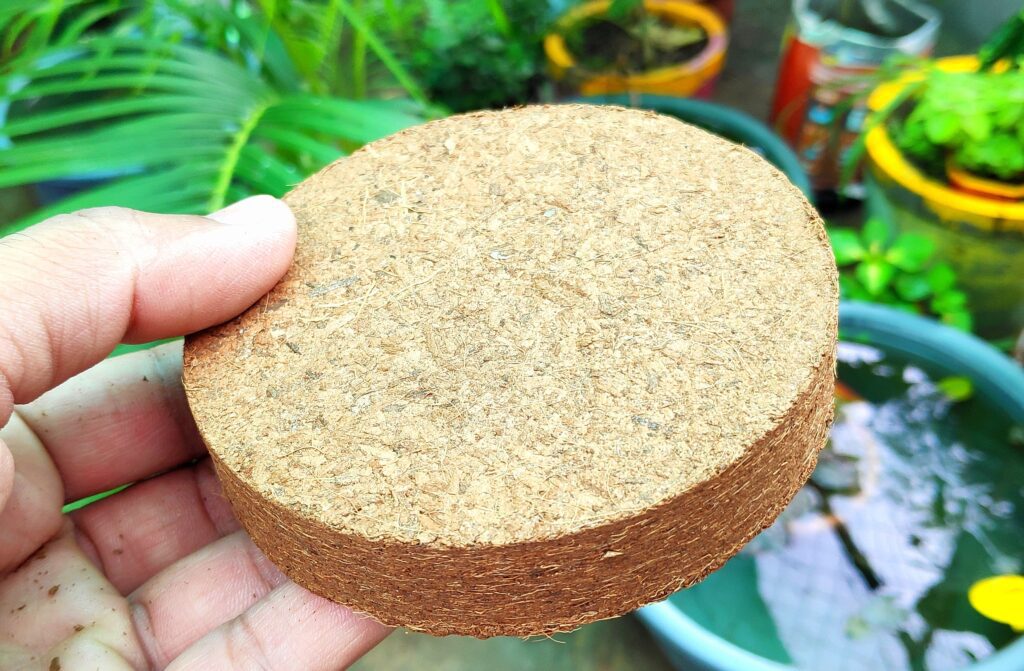
3. Enhanced Aeration: The coarse fibrous texture of cocopeat allows good aeration in the potting mixture. It facilitates a smooth flow of air, providing sufficient oxygen to the roots. It also prevents the soil from becoming compact and hard.
4. Excellent Water Retention: coco peat has excellent water retention properties. It can hold the water 8-10 times its weight, making it an ideal growing medium for those regions where water conservation is important.
5. Versatility: Coco peat can be used in various gardening applications, such as in potting mixtures, hydroponics, seed starting, soil amendment, and as a mulching material.
6. Improve Drainage: Its coarse fibrous structure also allows better drainage from potting soil and thus prevents waterlogging in planters, this helps to reduce the chances of root rot.
7. Eco-friendly and affordable: Coco peat is a 100% organic, non-toxic plant-based product, which is safe for both the environment and humans. Since cocopeat is made from waste coconut husk, it is also cheaper than other growing mediums, and can also be made easily at home.
8. Biodegradable: Coco peat is biodegradable, which means it can break down naturally over time.
After use, it can also be decomposed into nutrient-rich organic compost which further enhances the overall fertility of the soil.
Various applications of coco peat
- For making cocopeat pellet/coco discs, which are mainly used for seed germination.
- In hydroponics for holding the root system.
- To reduce soil compactness.
- For mulching, to avoid unwanted weeds.
- For propagating plant cuttings.
- As a rooting medium in branch air layering.
- In soilless farming.
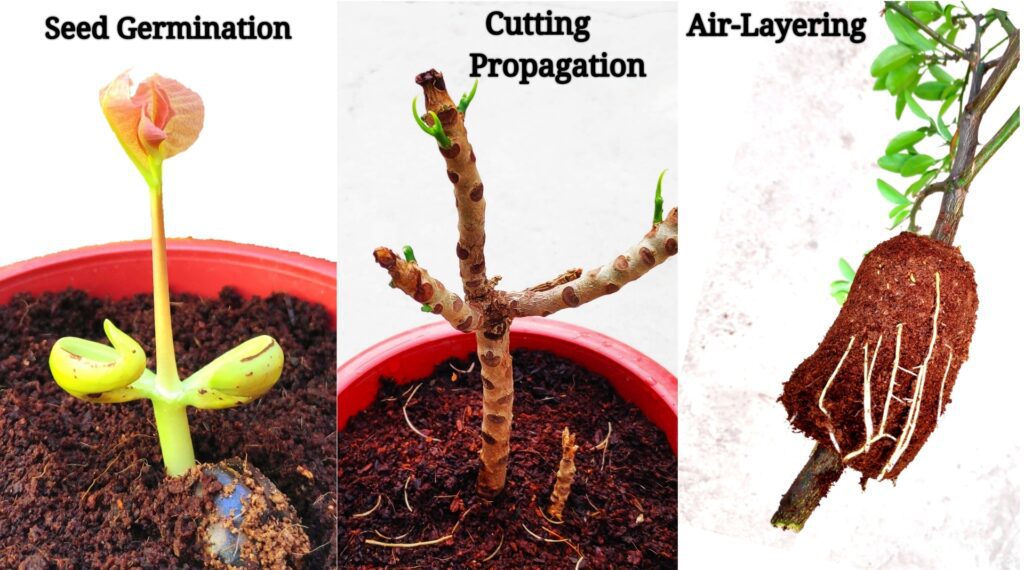
Benefits of using cocopeat in gardening
- Since cocopeat is lightweight, it can significantly reduce the overall weight of pots and grow bags which makes them much lighter and easier to move around when needed. This is particularly helpful for rooftop gardens.
- Provides proper aeration to the roots and improves drainage, preventing waterlogging and the risk of root diseases.
- Promoting better root growth.
- Its coarse fibrous structure improves soil structure and prevents soil compaction.
- Its moisture retention and aeration properties create favorable conditions for seeds and baby plants to sprout and develop healthy roots.
- Because of anti-fungal and disease-resistance properties, it can resist certain diseases, pests, and fungi. This reduces the need for chemical treatments and pesticides, making it a safer and more environmentally friendly option for gardening.
- Cocopeat naturally helps to control weed growth in your garden.
- Its fibrous texture provides a stable and supportive growing medium for plants, which makes it an excellent choice for hydroponic farming.
Process of making cocopeat at home

Here are some easy steps to make coco peat at home
- Collect some dried coconut. You can either buy them from the grocery store or obtain them from your own coconut fruit.
- Extract the outer fibrous husk carefully from the dry coconut fruit using a knife or machete.
- Cut these husks into small pieces.
- Leave the collected husks in full sunlight for 24 -48 hours to ensure no moisture in them.
- Once the coir husk is completely dry, break it into smaller particles by rubbing it between your hands or using any mixer grinder.
- After grinding those husks, you will receive a lot of coco coir dust.
- Soak for about 24-48 hours and rinse properly to reduce salt concentration from this coco coir dust.
- Squeeze out extra water from it. Now your homemade cocopeat is ready for use. You can also store it for future use.
How to use Coco Coir
Coconut husk, which is used to make cocopeat, naturally contains a higher amount of salt compared to other organic growing mediums. To minimize this, cocopeat manufacturers usually rinse and leach it properly. However, some manufacturers skip this step.
When we use cocopeat that hasn’t been properly rinsed and leached, for growing seeds or baby plants, there’s a higher risk of their spoilage.
Typically cocopeat is available in the form of compressed blocks of different sizes and powder form. These blocks are known as coco coir bricks or coco peat blocks. To use them efficiently follow these steps:
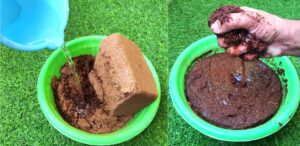
- Put coco coir brick in a big container and pour enough water into it.
- Allow it to absorb water for a few hours until it expands and becomes fluffy.
- Now, you can either rinse the cocopeat with clean water 2-3 times or gently squeeze it to remove salty water.
- For best results, use only 20-40% cocopeat in potting mix. depending on plant variety.
Limitations and drawbacks of using in gardening
- As coco peat contains high salt concentration, it can negatively impact seed germination and plant growth if not rinsed and leached correctly before use.
- Cocopeat has low inherent nutrient levels, so additional fertilizer is required to meet the nutritional needs of plants.
- Because of excellent water retention properties, cocopeat can hold moisture for longer periods. Hence frequent watering or over-watering can cause root rot.
- With repeated use and watering, cocopeat becomes compacted, reducing its ability to provide adequate aeration to plant roots, which causes poor root growth and overall plant health.
- Cocopeat decomposes slowly in the soil, which means it remains useless in the potting mixture for a long time.
Comparison of coco peat with other growing media
| Property | Coco peat | Vermicompost | Peat Moss | Vermiculite |
|---|---|---|---|---|
| Source | Coconut husks | Organic waste decomposed by earthworms | Decayed plant material | Natural minerals |
| Composition | Natural fiber | Organic matter and worms | Decomposed sphagnum moss | Natural mineral flakes |
| Water Retention | Excellent | Good | Excellent | Excellent |
| Aeration | Good | Excellent | Good | Excellent |
| Nutrient Content | Negligible | High | Low | None |
| pH Level | Slightly acidic to neutral | Slightly acidic to neutral | Very acidic | Neutral |
| Decomposition Rate | Slow | Moderate | Very slow | Does not decompose |
Tips and Techniques for Using Cocopeat Effectively
- Soaking and rinsing: Prior to using cocopeat as a growing medium or as a soil amendment, soak it in water to absorb sufficient moisture. After soaking, squeeze out extra water from it, this also helps to lower salt concentration from it.
- Provide adequate drainage: While using for seed germination, ensure to provide proper drainage in containers. This prevents waterlogging and allows excess water to drain out effectively.
- Monitor moisture: As cocopeat can hold moisture for longer hence before watering check the moisture level to avoid overwatering in plants. You can check the moisture either by hand or by using a moisture meter.
- Mix with other amendments: To create a well-balanced growing medium, mix it with other materials like perlite or compost. This combination also helps to improve, aeration, drainage, and nutrient retention in the potting mixture.
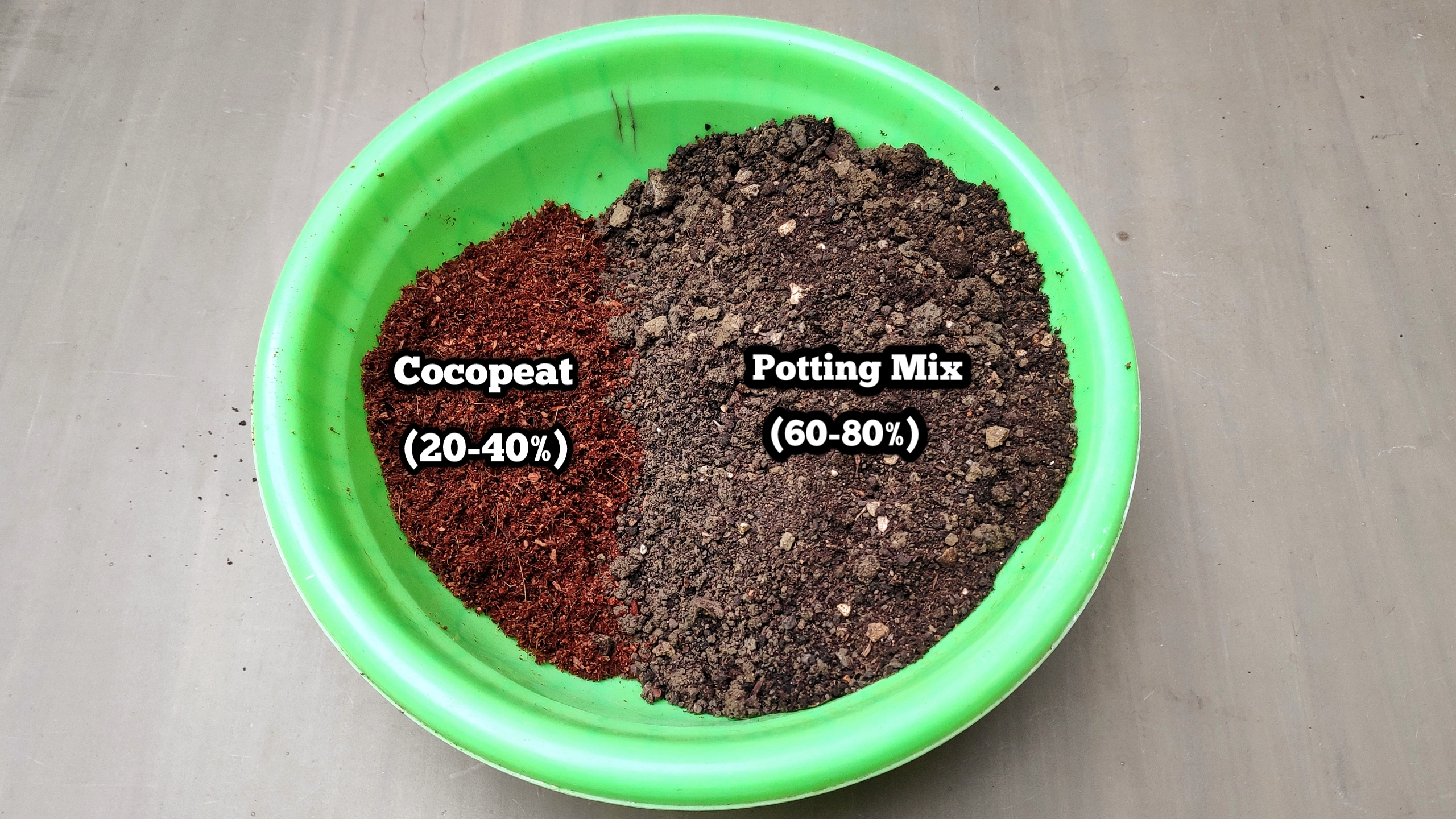
- Apply adequate fertilizers: Remember, cocopeat is not a fertilizer. Hence, for healthy plant growth, make sure to use enough fertilizer or organic compost.
- Recycling and reusing: Because of slow decomposition, you can reuse it. After each growing cycle, remove any plant debris or roots of old plants, rinse it thoroughly, amend it with fresh compost, and reuse it in your garden.
Common mistakes while using cocopeat
Mistake 1: Assuming as a compost
Many beginners make the mistake of assuming that coco peat alone can provide all essential nutrients to their plants. However, coco peat has some nutrients, but it’s not a complete fertilizer. Hence be sure to add adequate fertilizer to provide essential nutrients for plants for their healthy growth.
Mistake 2: Using unrinsed or low-quality coco peat
Being careful about using unrinsed and low-quality coco peat is essential for getting optimum results, as such types of coco peat may contain high salt levels and other harmful materials that could harm your plants. However, many people don’t realize this and use it directly in their gardens, which is not a good practice.
Mistake 3: Neglecting aeration and drainage
Even though fresh coco peat provides better aeration and good drainage, it still needs proper aeration and drainage support. As it gets compacted over time, it may restrict the flow of oxygen to the roots, hindering plant growth. To prevent this, using other soil amendments like perlite or vermiculite helps to improve the aeration and drainage of your potting mix.
Mistake 4: Overwatering the plants
Generally, people water their plants without checking the soil moisture. However, if they make the same mistake with a cocopeat-mixed potting mix, there are higher chances of root rot and poor plant growth. This is because coco peat has excellent water-holding capacity, and overwatering can cause excessive water accumulation near the roots.
Mistake 5: Ignoring pH Levels
Coco peat has a slightly acidic to neutral pH, which is suitable for most plants. but, its pH can vary depending on the source and process of manufacturing. Hence depending on the special plant variety and soil type, testing and adjusting soil pH before using, helps to get the optimum output.
Mistake 6: Reusing without proper treatment
As coco peat is reusable, many people directly use their old cocopeat without any prior treatment. However old used coco peat may contain plant debris, roots, and other residues, hence reusing without proper treatment may impact plant health.
By avoiding these common mistakes, and with a little care and attention, we can get amazing results from this fantastic and eco-friendly growing medium.
By-products of coconut husk
Coconut husk, the fibrous outer layer of coconuts, provides many valuable by-products that have various applications. These by-products are obtained by processing and utilizing the coconut husk waste. Here are some of the main by-products of coconut husk.
- Coco Coir Fiber: These are the long fibers extracted from coconut husks. These fibers are widely used for making-
- Ropes
- Filling material for mattresses
- Coir pots for garden
- Coco fiber poles to support climbing plants and vines
- Coir bird nests
- Coco Chips: The small pieces or chunks of coconut husk are known as coco chips or coconut husk chips. These are commonly used in
- Potting Medium
- For Mulching
- Orchid cultivation
- Coco coir dust (coco peat): Also known as coir pith or coir dust. It is mainly used in
- Horticulture and Gardening
- Seed Starting and Hydroponics
- In mulching
- Coconut Shell Charcoal: The hard coconut shells, which are part of the husk, can be transformed into charcoal through the carbonization process. This coco shell charcoal can be used as
- Fuel
- Activated Carbon, which is widely used in water purification.
Commonly Asked Questions
Does cocopeat provide nutrients to plants?
No, cocopeat doesn’t contain any nutrients itself, so it does not provide significant nutrients to plants.
Can we reuse cocopeat?
Yes, because of its slow decomposition cocopeat can be used again and again for seed germination.
Is coco peat a fertilizer?
No.
What can be used in place of coco peat?
Can we use coco peat for all plants?
Can I make coco peat at home?
Yes, anyone can easily make a small amount of cocopeat for their roof garden from dried coconut husk.
How much cocopeat should be mixed in the soil?
20% to 40% depending on the type of soil and the specific needs of your plants.
What is the price of 1 kg coco peat?
Around $10

